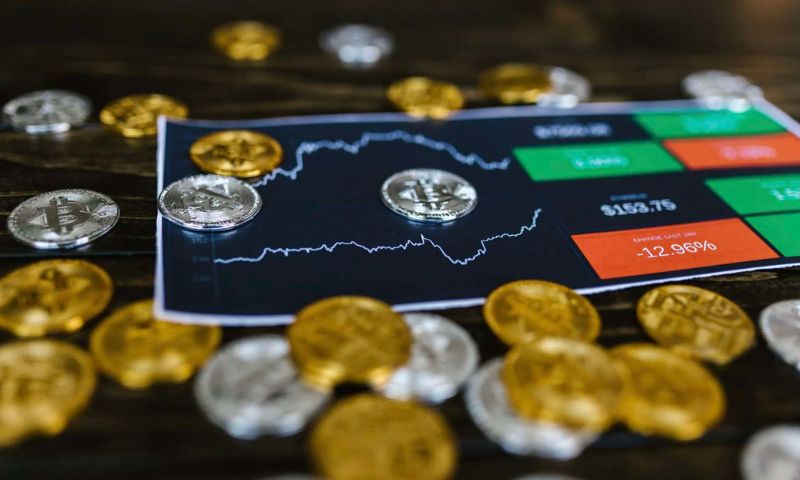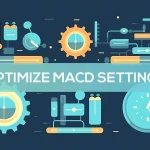Navigating the twists and turns of the cryptocurrency market might seem like a wild ride, but with technical analysis of crypto market as your guide, you’re on track to unlock the secrets to profit. Whether you’re new to the crypto scene or a seasoned trader, the following insights will empower you to chart a more precise course through crypto’s volatile waves. Ready to dive into the patterns and indicators that can signal your next smart move? Let’s break down the methods that will sharpen your trading game and boost your decision-making confidence.
Understanding the Foundations of Crypto Chart Analysis
The Importance of Candlestick Patterns in Cryptocurrency
Candlestick patterns are key to crypto chart analysis. They show price movement in a clear way. Each candlestick has a body and may have wicks at both ends. The body shows where a cryptocurrency opens and closes over a set time. If the close is above the open, the candlestick is often green or white. It’s red or black if below.
Wicks show the high and low prices hit during this time. These patterns can hint at future price swings. This makes them great for day trading digital currencies. A pattern with one long wick might tell you a price is reversing. Two candlesticks with small bodies after a long one can signal a trend change. Knowing these can be a big help in bitcoin trend prediction.
Incorporating Moving Averages and Bollinger Bands
Moving averages help smooth price data over time. They are a line on your chart. This line shows the average price over a number of days. It can be simple or exponential. Simple moving averages (SMA) take prices over a set time and average them. Exponential moving averages (EMA) do this too but give more weight to recent prices.
They’re good for spotting trends in cryptocurrency. If prices are above the moving average line, it could mean an uptrend. Below it may suggest a downtrend.
Bollinger Bands are a bit more complex. They take a moving average then add and subtract a standard deviation. This makes a channel.
Cryptos often move between the band’s upper and lower limits. If one falls outside, it can mean large price swings are upcoming. These bands are great for spotting volatility in cryptocurrency markets.
Using these tools together can give strong signals. For example, a price near the lower Bollinger Band and below the SMA might be a buy cue. This could be when planning crypto swing trading techniques or an altcoin price movement bet.
Remember, no tool predicts the future. Each just helps you make educated guesses based on past data. They show what might happen, not what will. But they are key parts in building strong crypto trading strategies. They can help you see what direction a blockchain asset graph might go.
Use them to understand market sentiment in crypto and to perform deep crypto volume analysis. Stick with these basics and you’re on a solid path to charting your way to profits.
Delving Into Advanced Technical Indicators
Applying MACD and RSI for Market Predictions
Let’s dive deep into MACD and RSI, two tech tools that help us win at crypto. MACD, or Moving Average Convergence Divergence, is like a crypto heartbeat. It shows if the market’s hot or cold. It flashes buy when it goes above its line, and sell when below. Simple, right? But don’t just trust one sign. We mix in RSI, the Relative Strength Index, for a second check. If RSI reads over 70, the market might drop soon. Under 30, and we could be heading up. They’re super for guessing where Bitcoin might jump next.
Mastering Fibonacci Retracements and Ichimoku Cloud
Next, there are two advanced tips my pals love for crypto. First, Fibonacci retracement. It’s based on math from way back that tells us key price spots. When prices zig-zag, Fib levels hint where the turns might happen. Traders use these points to make calls on altcoin price moves.
Then there’s the Ichimoku Cloud. Sounds fancy, but it’s just a chart tool that maps out potential support and resistance zones. It’s like drawing a line in the sand where prices might stop and think. It’s top magic for seeing trend switches before they’re news.
Armed with these tools, you’re ready for next-level crypto trading. Remember, practice makes perfect. Try these tricks out and watch your trades level up!
Crafting Effective Crypto Trading Strategies
Recognizing Chart Patterns for Trading Breakouts
Let’s talk about making money with crypto. It’s all about spotting the big moves before they happen. Picture this: You’re staring at a chart full of zig-zag lines and shapes. These shapes are chart patterns, and they are like secret signs. They whisper to us where the price might jump up or down big time.
These patterns have cool names like “head and shoulders” or “triangles.” When we see them, it tells us that prices might be about to make a big move. So, how do we use this to trade? We wait. We watch for the price to push outside the pattern. That’s our cue! When it happens, it’s like the starting gun of a race. We dive into action, buying or selling fast to grab profits.
Remember, we’re like detectives looking for clues. When we find them, and we’re right, we can earn some sweet cash.
Combining Elliot Wave Theory with Crypto Scalping Techniques
Next up, let’s mix it up with waves and quick trades, known as scalping. Heard about the Elliot Wave Theory? It’s like surfing. We ride the ups and downs of prices, called waves. They follow rules and patterns. There are impulse waves that push prices up and correction waves that bring them down. But here’s the secret: these waves show up in patterns, and these patterns repeat. If we can spot them, we can ride the wave just right.
Now, toss in scalping. Scalping is the art of making quick, small trades. It’s like being a ninja! We jump in fast, make a little profit, and pop out before anyone notices. It’s all about speed. We use what we know about the Elliot Wave Theory to pick our moments.
To scalp in crypto, practice is key. We’ve got to be fast and keep our cool. It’s like playing a video game where timing is everything. We watch, we wait, and wham! We make our move and then we’re gone, off to plan the next attack.
By combining these moves—the waves and the scalping—we make a strategy that’s all about quick thinking and cool moves. It’s not easy, but oh boy, can it pay off if we get it right. We have to be on top of the game, watching those charts and ready to jump at the right wave. And remember, don’t get greedy. Quick in, quick out—that’s how scalping works best.
Trading crypto is an adventure. It’s fast, fun, and it can fill your pockets if you play it smart. So grab those charts, look for patterns, ride the waves, and make those quick ninja moves. That’s how you can chart your path to profits.
Managing Risks and Leveraging Market Volatility
Establishing Solid Crypto Trading Risk Management Practices
Managing risks is key to trading success, especially in the wild world of crypto. It’s like putting on armor before heading into battle. You wouldn’t ride into the fray unguarded, right?
To “armor up” in trading, you start by setting stop losses. A stop loss is a tool that saves your money if the price drops a lot. Think of it as a safety net. You decide in advance how much you can bear to lose, and set a stop loss at that level. If the price hits this point, your trade closes automatically to keep losses under control.
Another tip is to only risk a small part of your total money. Many traders stick to risking just 1-3% per trade. This way, no single loss can wipe you out. It’s like not putting all your eggs in one basket.
Keeping track of all trades is smart, too. A trade journal helps you learn from wins and losses. Plus, understanding how your emotions affect trading is useful. Do you buy out of fear of missing out? Or sell because you panic? Spotting these habits can lead to better decisions.
Last, know the news. Big news can move markets. Be ready for anything – it’s all part of the game.
Drawing Trend Lines and Identifying Harmonic Patterns for Market Timing
Trend lines and harmonic patterns are road maps for buying and selling your crypto. They’re tools that help you make sense of the crypto chart’s ups and downs.
A trend line is a simple straight line that connects price points on a chart. It shows if the price is generally moving up or down. To draw one, spot two or more high or low points on the chart, and connect them. Breaking through a trend line might signal a big price move, giving you a cue to enter or exit a trade.
Harmonic patterns are like special shapes on the chart that can predict future moves. They’re based on Fibonacci numbers – a string of numbers where each one is the sum of the two before it. These patterns need a keen eye but reward you with solid info on where prices might head next. The Gartley, Bat, and Butterfly are just a few pattern names you might hear.
Finding these patterns takes practice. When you spot one, it hints at where the price might go. It’s like finding a secret rhythm in the price’s dance.
In crypto, prices jump up and down a lot. This is volatility. With a good eye for trend lines and harmonic patterns, you can ride these big moves to make a profit. This market timing can be tricky but super rewarding when done right.
To wrap it up, trading crypto safely means managing risks and reading the market’s tunes. Set stop losses, don’t bet the farm on one trade, keep a journal, stay on top of news, and learn to draw trend lines and spot harmonic patterns. With these tips, you put yourself on a path to trading smarter, not just harder. Happy trading!
In this guide, we’ve walked through the essentials and advanced methods of crypto chart analysis. We started with candlesticks and how they shape market views. Then, we added moving averages and Bollinger Bands to our toolkit.
We stepped up our game learning MACD and RSI. These can hint at future market moves. We also explored the power of Fibonacci and Ichimoku Cloud.
Next, we tackled creating strong trading plans. Recognizing chart patterns and using Elliot Wave and scalping were key.
Lastly, we covered managing risks in volatile markets. Solid risk management and trend lines are vital for smart timing.
I believe that with these tools, you can navigate the crypto market better. Stick with these strategies, keep learning, and always play it smart with risks. Let’s make smart moves and aim for success in trading!
Q&A :
What are the key indicators used in the technical analysis of the crypto market?
Technical analysis of the crypto market relies on various indicators to predict future market movements. Some of the key indicators include the Relative Strength Index (RSI), Moving Averages (MAs), Fibonacci Retracement levels, MACD (Moving Average Convergence Divergence), and Bollinger Bands. Traders use these to identify trends, momentum, and potential reversal points in the market.
How does technical analysis differ from fundamental analysis in cryptocurrency trading?
Technical analysis and fundamental analysis are two distinct approaches used in cryptocurrency trading. Technical analysis focuses on statistical trends derived from trading activity, such as price movements and volume. It examines patterns and uses various analytical tools to forecast the direction of future prices. In contrast, fundamental analysis evaluates a cryptocurrency’s inherent value by examining related economic, financial, and other qualitative and quantitative factors. This could include the project’s underlying technology, team, market demand, and regulatory environment.
Can technical analysis predict cryptocurrency prices with certainty?
No, technical analysis cannot predict cryptocurrency prices with certainty. While it can provide insights into potential price movements based on historical data and statistical trends, it’s important to understand that the crypto market is highly volatile and can be influenced by numerous unpredictable factors. As a result, technical analysis should be used as one component of a comprehensive trading strategy, often in conjunction with fundamental analysis and risk management techniques.
Is technical analysis reliable in the highly volatile crypto market?
Technical analysis can be reliable in the crypto market, but its reliability is affected by market volatility. High volatility can lead to false signals and unexpected market moves that can challenge the predictive power of technical indicators. However, many traders still find it a valuable tool when combined with other methods, including a thorough risk management strategy. It’s important for traders to be flexible and adapt their analysis to the rapidly changing market conditions.
How important is charting in the technical analysis of cryptocurrencies?
Charting is a fundamental aspect of technical analysis in cryptocurrencies, as it provides a visual representation of price movements and patterns over various time frames. Charts help traders identify trends, support and resistance levels, chart patterns, and trading volumes, which are crucial for making informed trading decisions. Without charting, conducting a technical analysis would lack the necessary context provided by the historical price and volume data.





